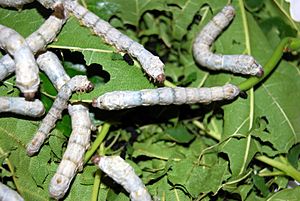Amelia Tonon facts for kids
Quick facts for kids
Amelia Tonon
|
|
|---|---|
| Born | 23 March 1899 Trieste (now Italy)
|
| Died | 21 August 1961 (aged 62) Padua, Italy
|
| Nationality | Italian |
| Alma mater | University of Padua |
| Occupation | Entomologist |
| Known for | Research into silkworms and crossbreeding |
Amelia Tonon (1899–1961) was an Italian scientist who studied insects, especially silkworms. She researched their eggs and how to crossbreed them. She also invented a special way to stain embryos, which are tiny, developing creatures.
Contents
A Life of Science
Amelia Tonon was born in Trieste on March 23, 1899. At that time, Trieste was part of the Habsburg monarchy, but it is now part of Italy. When she was a teenager, Amelia moved to Padua, Italy. There, she studied natural sciences at the University of Padua.
Starting Her Research Career
In 1923, Amelia began working as a researcher at the Experimental Zoological Station of the University of Padua. This was a temporary job at first. However, she worked hard and won a competition for a permanent research position the next year. She also earned a license to teach, adding more skills to her scientific background.
In 1928, Amelia spent three weeks as a visiting researcher at the Naples Zoological Station. This gave her a chance to learn and share ideas with other scientists.
Studying Silkworms
Except for her short time in Naples, Amelia Tonon worked only at the Zoological Station of Padua. Her main focus was on silkworms. She studied how to keep their eggs safe and how to treat them.
She looked closely at the tiny cells inside silkworm eggs, especially the vitelline cells. These cells are important for the egg's development. Amelia also studied problems that could happen during the silkworm's growth, like unusual changes in their development. She was very interested in albinism, which is when an animal lacks color, and how it affected silkworm larvae.
New Discoveries and Inventions
Amelia Tonon made an important invention: a new way to stain embryos. Staining helps scientists see tiny parts of an embryo more clearly under a microscope. She received a patent for this new method. When other researchers started using her technique, it became much easier for them to watch how an embryo developed.
Besides embryos, Amelia also studied how silkworm eggs reacted to things like ultraviolet rays and steam tar. Her later research focused on breeding different types of silkworms together. She was very successful in creating new, valuable breeds. She also studied the structure of mulberry buds, which are the leaves that silkworms eat.
Amelia Tonon passed away in Padua on August 21, 1961. Her work helped us understand more about silkworms and their development.
Images for kids



